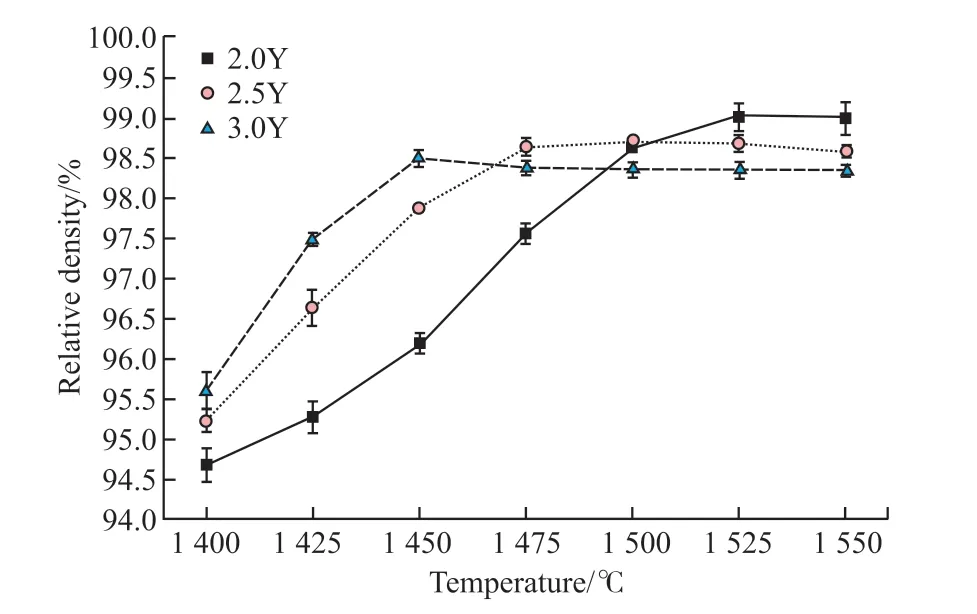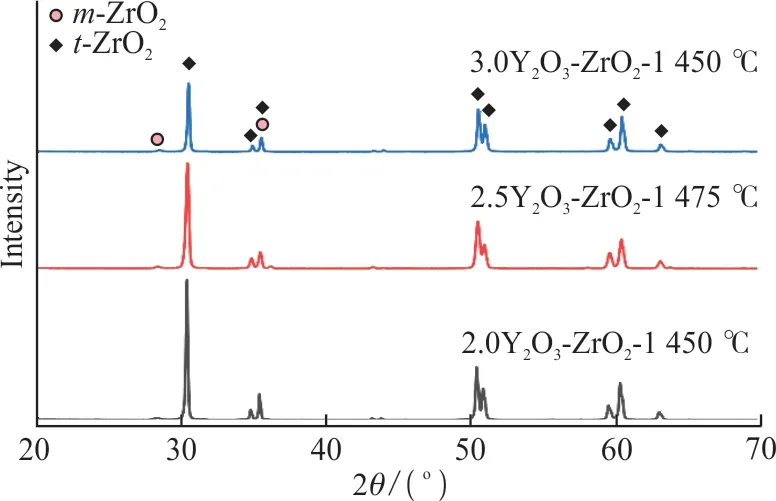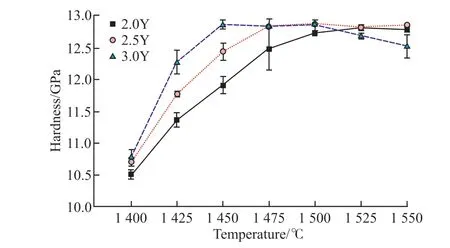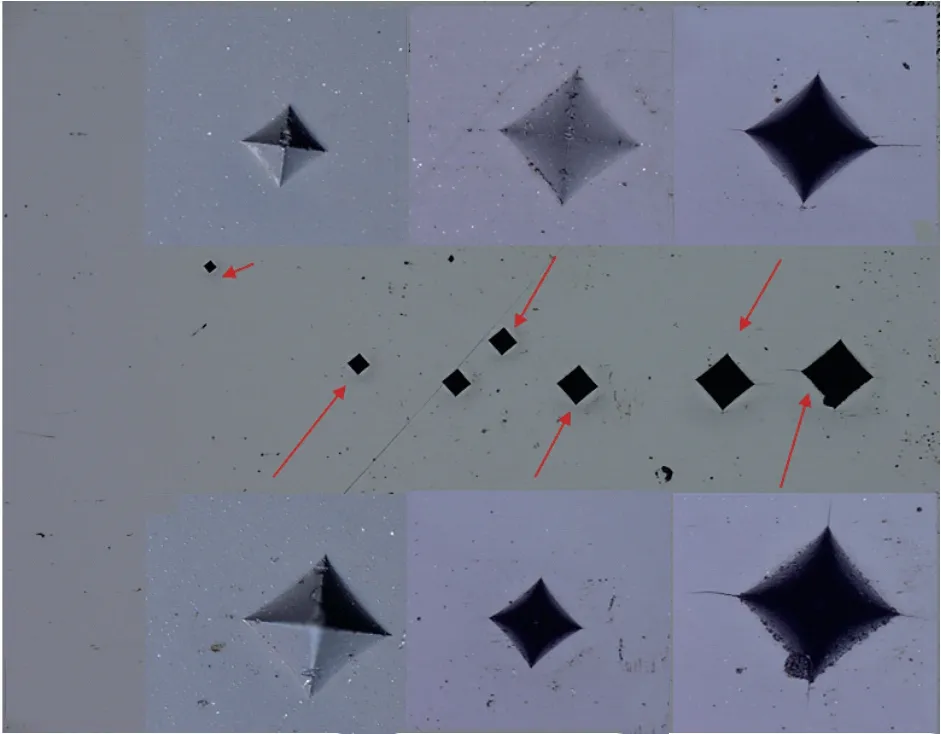Preparation and Mechanical Properties of Zirconia Ceramics Doped with Different Y2O3 Contents
2024-01-03SONGYanweiZHAOXiaoqingWANGAiyangXIONGYanDONGYanlingWANGWeiming
SONG Yanwei, ZHAO Xiaoqing, WANG Aiyang, XIONG Yan,DONG Yanling*, WANG Weiming*
(1. State Key Laboratory of Advanced Technology for Materials Synthesis and Processing, Wuhan University of Technology, Wuhan 430070,China; 2. School of Materials and Chemical Engineering, Hubei University of Technology, Wuhan 430068, China)
Abstract: The sintering behavior and mechanical properties of zirconia doped with 2.0mol%-3.0mol%Y2O3 were studied by pressure-less sintering.The experimental results show that the densification temperature of zirconia ceramics increases gradually with the decrease of Y2O3 doping content by which decreases the sintering driving force due to the lower oxygen vacancy concentration of the systems.Furthermore, the bending strength and fracture toughness of the prepared zirconia ceramics increase with the decrease of Y2O3 doping content.It can be attributed to the fact that the phase stability of tetragonal zirconia decreases with the decrease of Y2O3 doping content, which is easier to induce "phase transformation toughening" and dissipate impact energy.The relative density, bending strength and fracture toughness of 2.0mol% Y2O3 doped zirconia ceramics (2.0Y-ZrO2)sintered at 1 525 ℃ are 99.00%, 1 256.65±20.82 MPa and 9.85±0.13 MPa·m1/2, respectively.
Key words: yttria-stabilized tetragonal zirconia polycrystal (Y-TZP) ceramics; sintering behaviors;mechanical properties
1 Introduction
The advent of the 5G era has put forward higher requirements for the performance of phone backplane materials.At present, the materials used for the backplane of mobile phones mainly include ceramics,glass, metal and plastic.The main performance comparisons are shown in Table 1[1,2].5G era requires faster signal transmission, 1 to 100 times faster than 4G.With the wide application of wireless charging and the near field communication, intelligent devices have increasingly high requirements for signal transmission,and electromagnetic shielding performance is greatly valued in the field of communication[3].Compared with the metal backplane, ceramic backplane has no interference to signal and has incomparable superior performance of other materials, which is favored by mobile phone manufacturers[4].
Among all-ceramic materials, zirconia ceramics have the advantages of high strength, high hardness,wear resistance and corrosion resistance, no signal shielding, high dielectric constant and electrical signal sensitivity[5,6], as well as the characteristics of special“phase transformation toughening” mechanism:When stressed, zirconia will undergo martensitic transformation from tetragonal phase to monoclinic phase, so as to absorb some energy and improve the brittleness of ceramic materials[7].However, the phase transition of zirconia is often accompanied by drastic volume changes, resulting in material cracking.The method to stabilize the crystal structure of ZrO2is generally by adding some oxides (such as Y2O3, CaO,MgO, CeO2and other rare earth oxides) with ionic radius similar to Zr4+into the ZrO2system[8,9], which can form a solid solution with ZrO2[10].This enables ZrO2to have a partially or completely stable structure at room temperature[11], showing excellent mechanical properties.Y2O3doped ZrO2Ceramics (Y-TZP) are widely used because of their fine grains, low sintering temperature, high content of tetragonal zirconia and superior mechanical properties at room temperature[12,13]with a bending strength of 700-1 600 MPa, a fracture toughness of 4-15 MPa∙m1/2, and stable chemicalproperties[5].At the same time, Y-TZP ceramics have a significant disadvantage.When the ceramics are used for a long time at a low temperature of 100 - 400 ℃, it will lead to a phenomenon of low-temperature aging,which seriously hinders its application in practical engineering to a certain extent[14-16].Therefore, it is also a great research direction to explore the way to improve the low-temperature aging resistance of Y-TZP ceramics.
At present, the sintering methods of zirconia ceramics include pressure-less sintering, hot pressing sintering, oscillating pressure sintering, spark plasma sintering, microwave sintering and so on[17-21].Xueet al[22]prepared fully densified (> 99%) 2.0Y-ZrO2ceramics by spark plasma sintering, and its fracture toughness is 9.73 MPa∙m1/2.Wang[23]fabricated Y-TZP by microwave sintering technology.The bending strength and fracture toughness were 1066 MPa and 10 MPa∙m1/2, respectively.Liet al[24]manufactured 3.0Y-ZrO2ceramic with excellent mechanical properties using oscillatory pressure sintering.As comparison,zirconia ceramics were sintered by pressure-less sintering method and hot pressing sintering method at same temperature.Due to the refinement of grains and the increase in relative density, the oscillating pressure sintering zirconia presents an increase in bending strength from 1 003 MPa in pressure-less sintering and 1 234 MPa in hot pressing sintering to 1 572 MPa.It was believed that the oscillatory pressure could strengthen the plastic deformation and grain boundary slip of grains at high temperature, which inhibits the migration of grain boundaries and the excessive growth of zirconia grains, thus significantly improves the mechanical properties[25,26].However, oscillatory pressure sintering is difficult for use in industrial applications due to that its densification mechanisms is not clear and the equipment technology is also not mature.In contrast, the traditional sintering method of pressure-less sintering is more suitable for industrial production.
The pressure-less sintering method is the simplest and most feasible, with low experimental cost and no pressure and atmosphere requirements.At the same time, compared with the pressure-assisted sintering methods that the stress distribution of the specimen mold needs to be considered, the shape of the pressureless sintered specimen is more diversified, making it easy to adapt to the complex shape design of the mobile phone backplane.In this paper, the effect of different Y2O3content on the sintering behavior and mechanical properties of zirconia ceramics were studied by pressure-less sintering, so as to prepare high-strength zirconia ceramics.
2 Experimental
The zirconia powder doped with Y2O3content of 2.0mol%, 2.5mol%, and 3.0mol% (2.0Y-ZrO2,2.5Y-ZrO2, and 3.0Y-ZrO2) were characterized by SEM observation and XRD analysis respectively.As shown in Fig.1, they had a size of 70-80 nm with uniform size distribution, which was a mixture of monoclinic zirconia (m-ZrO2) and tetragonal zirconia (t-ZrO2).
Zirconia powders doping with different Y2O3content were shaped by pressing which the diameter of stainless-steel mold was 60 mm and the pressure was 10 MPa.The green body after molding was treated at 200 MPa in a cold isostatic press (CIP, LDJ100/320-300), then a uniform and compact ceramic green body was produced.Finally, the press-formed body was sintered in a muffle furnace at a heating rate of 5 ℃/min.
After pressure-less sintering, the zirconia ceramics were processed into specimen strips, looked no scratches and smooth, for testing by diamond wheel cutting machine (HS-100), precision surface grinding machine (ACC-63DX), polishing machine(Tegramin-25) and other processes.The Archimedes method was used to measure the density and then its relative density was calculated.Vickers hardness was measured with a Vickers hardness tester (FALCON 400) with a load of 98 N and a dwell time of 15 s.The phase composition of the zirconia specimens was detected by X-ray Diffraction (XRD, Uitima III).The polished surface and fracture surface of zirconia specimens were observed by field emission scanning electron microscope (FESEM, FEI Quanta-250),and the grain size and distribution were counted.The bending strength of the zirconia specimens was measured by an electronic universal testing machine(CMT6503), the loading speed was 0.5 mm/min, the size of the measured zirconia specimens was 3 mm ×4 mm × 36 mm, and the number of specimens was 10.The fracture toughness (KIC) of the zirconia specimens was measured by the Indentation Method, and the fracture toughness was calculated by measuring the diagonal length of the indentation and the half-crack length.The specific calculation formula is shown as follows[27]:
where,Eis the elastic modulus (Pa),HVthe Vickers hardness (Pa),Pthe load (N),cthe crack half length(mm), andathe indentation half length (mm).
3 Results and discussion

Fig.2 Relative density of zirconia specimens at different sintering temperatures
The relationships between the relative density and sintering temperature of the three groups of zirconia specimens doped with different Y2O3contents are shown in Fig.2.The relative density of 2.0Y-ZrO2,2.5Y-ZrO2, and 3.0Y-ZrO2ceramic specimens increased first and then remained basically unchanged with the increase of sintering temperature.The three groups of specimens reached the maximum relative density (above 98.5%) around 1 525, 1 475, and 1 450℃, respectively.At the same time, with the increase of Y2O3,the densification temperature of zirconia specimens decreased.Boriket al[9,28,29]proposed that the addition of stabilizer Y2O3can make more Y3+enter the ZrO2lattice to increase the concentration of positively charged oxygen vacancies and promote sintering.The sintering driving force of zirconia ceramics is related to the oxygen vacancy concentration in the crystal lattice.The higher the concentration, the easier the densification of the specimens[10].The specific defect equation is as follows[30]:
XRD analysis was carried out for the sintering temperature at which three groups of zirconia specimens doping with different Y2O3reached maximum relative densities, as shown in Fig.3.It can be seen that with the decrease of Y2O3content,the content of tetragonal zirconia increased.When subjected to stress, the degree of tetragonal phase that can be transformed into monoclinic phase to absorb energy increases, which is conducive to the improvement of its mechanical properties.

Fig.3 XRD patterns of zirconia specimens with different Y2O3 contents
The polished surface and fracture surface of zirconia specimens at the three optimum sintering temperature were observed and their grain size distributions were counted, as shown in Fig.4.The zirconia samples of 3.0Y-ZrO2-1 450 ℃and 2.5Y-ZrO2-1 475 ℃ had obvious grain pullout phenomenon.With the increase of sintering temperature, the grains grew significantly.However, on the premise of densification, the grains can still be kept fine.At the same time, the particle size distribution was gradually dispersed compared with the average particle size, and the particle size distribution range was wider.Larger grains can contact more relatively small grains,and the bonding between grains was more stable.
Fig.5 shows the Vickers hardness of zirconia specimens at different sintering temperatures.With the increase of sintering temperature, the Vickers hardness first increased and then remained basically unchanged or decreased slightly Vickers hardness increased rapidly, mainly because the increase of sintering temperature led to the increase of grain size, the increase of relative density of ceramics, and the gradual reduction of defects such as pores[31].At the same time,with the increase of Y2O3stabilizer and Y3+replacing Zr4+, the lattice will be distorted.The generation of oxygen vacancy provided additional driving force for sintering, further improves the relative density and Vickers hardness value accordingly[12].When the sintering temperature was low, the Vickers hardness of 3.0Y-ZrO2zirconia ceramics was relatively high,and started to decrease when the sintering temperature was 1 525 ℃, which can be attributed to the abnormal growth of the grains due to the excessive sintering temperature.
Fig.6 is a schematic diagram of the indentation and cracks of zirconia samples under different loads.Under the loads of 9.8-98 N, no obvious cracks were observed around the indentation.Crack propagation was the main way for brittle materials to dissipate impact energy, indicating that the material had good toughness, but the fracture toughness cannot be calculated by formula.When the load was increased to 196 N, fine cracks were observed.When the load increased to 294 N, the cracks were more obvious.

Fig.4 SEM and grain size distribution images of polished surface and fracture surface of zirconia specimens with different Y2O3 contents: (a,d) 2.0Y-ZrO2-1 525 ℃; (b, e) 2.5Y-ZrO2-1 475 ℃; and (c, f) 3.0Y-ZrO2-1 450 ℃

Fig.5 Vickers hardness of zirconia specimens at different sintering temperatures

Fig.6 Indentation and crack diagram of zirconia ceramic specimens under different loads: (a)9.8 N; (b)29.4 N; (c)49 N; (d)98 N;(e)196 N; and (f) 294 N

Fig.7 Bending strength and fracture toughness of zirconia specimens with different Y2O3 contents
Fig.7 shows the changes of bending strength and fracture toughness of zirconia specimens with different Y2O3content.With the increase of sintering temperature, the bending strength and fracture toughness values of 2.0Y-ZrO2, 2.5Y-ZrO2, and 3.0Y-ZrO2zirconia specimens increased first and then decreased slightly.The bending strength of the three groups of zirconia samples reached the maximum values at 1 525, 1 475, and 1 450 ℃: 1 256.65 ±20.82, 1 081.03 ± 20.07, and 1 049.69 ± 10.50 MPa.The fracture toughness reached the maximum value at 1 525, 1 500, and 1 475 ℃, which are 9.14±0.08,9.01±0.12, and 8.67±0.10 MPa·m1/2, respectively.The improvement in mechanical properties was due to the fact that the samples have reached a high density (above 98.5%) at the optimal sintering temperature[32], and then there was a slight decrease due to the coarsening of the grains due to the high temperature.When the sintering temperature was constant, with the decrease of the doping Y content, the stability of the tetragonal zirconia decreased, and it was easier to induce the'phase transformation toughening' of the zirconia, and the mechanical properties of the material were better[33].
4 Conclusions
Three groups of zirconia powders doped with Y2O3content of 2.0mol%, 2.5mol%, and 3.0mol% were prepared by pressure-less sintering to prepare highstrength and high-toughness zirconia ceramics.The influence of Y2O3stabilizer content on the mechanical properties of zirconia ceramics was analyzed by SEM,XRD and mechanical properties of zirconia specimens:
a) By doping Y2O3in zirconia powder, the densification temperature of ceramic samples can be reduced.The lower the content of Y2O3, the tetragonal zirconia was more prone to 'phase transformation toughening' and improve the mechanical properties.
b) The content of Y2O3can affect the bending strength and fracture toughness of Y-stabilized zirconia(Y-TZP) ceramics.The lower the content of Y2O3, the tetragonal zirconia was more prone to undergo 'phase transformation toughening' and improve the mechanical properties.
c) The zirconia sample (2.0Y-ZrO2) with doping content of 2.0mol% Y2O3has the best mechanical properties under pressure-less sintering at 1 525 ℃,and the relative density, Vickers hardness, flexural strength and fracture toughness were 99%, 12.83 GPa, 1256.65±20.82 MPa, and 9.85±0.13 MPa·m1/2,respectively.
Conflict of interest
All authors declare that there are no competing interests.
杂志排行
Journal of Wuhan University of Technology(Materials Science Edition)的其它文章
- Enhanced Electrochemical Performances of Ni Doped Cr8O21 Cathode Materials for Lithium-ion Batteries
- Design on the Prestressed Concrete Frame Beam-column
- Synthesis and Flocculation of Polyacrylamide with Low Water Absorption for Non-dispersible Underwater Concrete
- Experimental Behavior of Recycled Aggregate Concrete Filled Steel Tubular Columns
- Impact-abrasive Wear Behavior of ZTA and NbC Reinforced Fe60 Matrix Composites
- Synthesis and Characterization of Hollow Strontium Carbonate Pompons by Composite Soft Template Method
